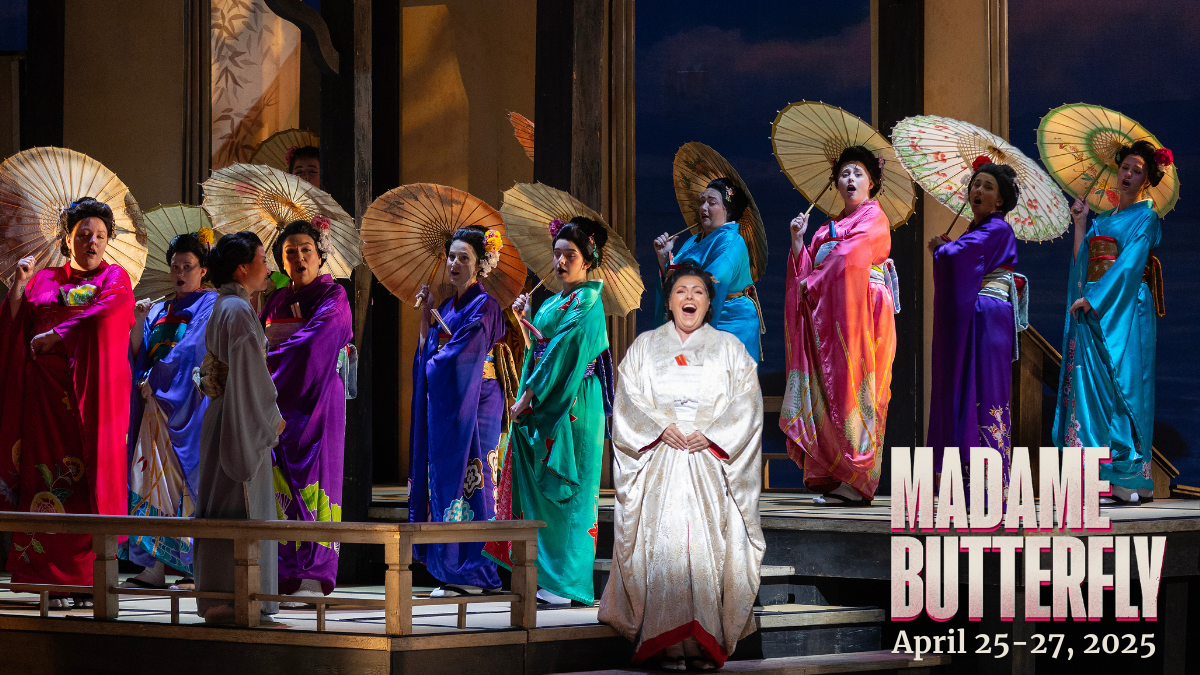The old war-horse Madame Butterfly was recently restaged by Austin Opera in a thoroughly enjoyable performance. Ever since its debut in 1904, it has become a canonical opera, likely seen by more people than another other with the possible exception of Aida. But unlike that Verdi opera, Puccini’s Butterfly can be staged in much smaller settings; I was treated to a performance in the Grand Bellagio Hotel in Italy a few years ago, while on an exclusive trip accompanied by an operatic troupe.
The stage at the Long Center here in Austin allowed the opera to breathe on a stunning set that looked absolutely entrancing when set at night, lit by lanterns. The 3D effect, with distant water and mountains, seemed quite realistic. Those who wanted a history lesson on how the opera has been staged over the past 121 years were treated to a thoughtful display in the lobby, complete with some costumes. Many fabulous, colourful costumes graced the stage (see lead photo).
The lead role was, rather unusually, sung by two sopranos. I saw Raquel Gonzalez (wearing white in lead photo), but on one of the three performances the role was filled by Yulia Lysenko. Her love interest, the caddish Lt. Pinkerton, was played by Joseph Dennis. Both delivered flawless and empathic characters in this highly emotional opera.
I asked one person who has always wanted to see this opera what his impressions were.
“Madame Butterfly is a tragically beautiful opera. It’s guaranteed to catch you off-guard if you’re not carefully paying attention to the story as its transformation from Beauty to Beast is a swift one. The opera was a must-see for me because it spoke to all the familiar true-life tragic love stories during that time.
“It was also a must-see because from what I’d been told by others it has always been consistent with the telling of the story. In my opinion, this is the reason why it is such a beloved opera. I’ve waited more than a decade to see this, and as the saying goes, ‘good things come to those who wait.’ In this case, patience was truly a virtue. I’m glad that I was able to see a truly beautiful piece of artistry.”
As the curtain closed on Madame Butterfly, Austin Opera entered a new phase of its existence.
“For the next several months Austin Opera will operate remotely as our new home undergoes its transformation into the Butler Performance Center,” writes Annie Burridge, General Director and CEO of Austin Opera. “Over the coming months there will be several opportunities to learn about our plans online and at events around the community, culminating with our 40th Birthday Celebration Concert at the Long Center in November. Once our new home and rehearsal facility open in 2026, we look forward to returning to fully staged experiences at the Long Center while introducing you to additional operatic experiences at the Butler Performance Center.
On May 9, 2025, the Austin Opera administrative staff began working remotely while the new Butler Performance Center (see photo) undergoes construction.
5811 Trade Center Drive will be transformed from a well-appointed, bright, and expansive administrative office building into a state-of-the-art performance center complete with a 185-seat theater with deluxe retractable seating, four rehearsal studios, a costume shop, conference center, and outdoor reception area. Pro-bono General Contractors Liza Wimberely and Tina Barrett will oversee the retrofit, which includes construction on the theater, theater lobby, new bathrooms, rehearsal studios, and the costume shop. The work is scheduled to be completed in early 2026, with opening events planned for that spring.

The Inspire 2030 movement will make this transformative project a reality, funding the purchase and retrofit construction through $8.5 million in capital investments, all while bringing new audiences and donors to Austin Opera. To date, $5 million in pledges and gifts have been secured to fund the project.
Find out more about how you can join the movement online, and stay tuned for more updates through our eNewsletter.”
www.austinopera.org
